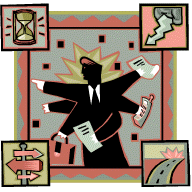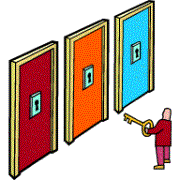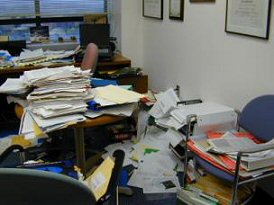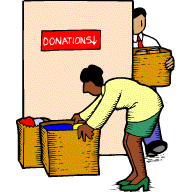
|
||
| Published by Kathy Paauw Organizing & Productivity Consultant Certified Business & Personal Coach |
Paauwer Tools is a Monthly Ezine February 2004 Issue 48 |
|
|
||
Over the holidays I met with a personal image consultant. Why? Because I recognize that I am not objective about the best personal choices for hairstyle, makeup, and wardrobe. There were too many options to choose from, and I inevitably made choices that I was not happy with. Take my hair, for example. Until I met with my image consultant, I didn’t know what hairstyle I wanted -- I just knew that I didn’t like the style I had! I needed someone objective to give me limited choices, based on what would work best for me. Prior to working with a consultant, I had always selected hairstyles I liked from fashion magazines. The problem was that these styles were not necessarily right for my hair type, face shape, and lifestyle. Then there’s make-up. Going to the department store or the drug store to buy make-up is a mind-boggling experience. There are so many different types and shades of make-up to choose from. How do you know which products are best for your skin type and skin tone? How do you know what you need in order to enhance certain features and diminish others? Once you get these products home, how do you most effectively apply the make-up to achieve the right effect? Before meeting with my image consultant, I had a cabinet full of skin care products and make-up that I would never use because they were not the right products for me. Last but not least, there’s clothing. What ever happened to the days when you could just go into a department store and ask for a pair of jeans? Purchasing clothing used to just take a few minutes. Now it’s a complex decision that can become a day-long project. Today’s store clerk typically asks much more than what size you wear…do you want slim fit, easy fit, relaxed fit or baggy? Do you want stone-washed, acid-washed, distressed, faded, or regular? Do you want boot cut, flair, or straight leg? Do you want button-fly or zipper-fly? Do you want hemmed or cut-off? And the list goes on. Modern life and increased affluence brings with it a plethora of choices. For example, there are more than 360 types of shampoo, conditioner and moose, 80 types of painkillers, and 40 types of toothpaste to choose from. Do more choices bring us greater happiness and fulfillment? According to Barry Schwartz, social scientist and author of The Paradox of Choice: Why More is Less, our unprecedented material abundance has become a cause of unhappiness. Depression has skyrocketed. There comes a point, Schwartz contends, at which choice becomes debilitating rather than liberating. Schwartz suggests four steps you can take so the choices you have don’t overwhelm you:
We naturally limit our choices in some circumstances. For example, my brother-in-law is getting a PhD in linguistics in Indo-Austranesian languages. There are only three universities in the USA that offer studies in this highly specialized field, so he is clear about his limited choices. When we are not clear about the goal or result that we want, we tend not to limit our choices. That's when all of the options can become overwhelming. My work with an image consultant has already paid for itself. Now that I'm clear about what choices are best for me, I won't waste my time and money shopping for products that will not meet my needs. No more experimenting with dozens of products to make my hair look "better" without having any idea as to what I really want. When I go shopping at the cosmetics counter, I know exactly what I need, which saves me time and money. Now I'll purchase only the products that are right for my skin tone and type that will produce the effect I want. When I go shopping for clothes, I'll know what colors and styles look best on me, so I won't waste my time considering the other choices. I can now aim for my targeted look with a precise arrow rather than with a flying barn! I recently saw a t-shirt that said, "Whatever look you were going for, you missed it." There's a lot of truth to that statement when we don't limit our choices to what is right for each of us.
What's Cluttering Up Your Life?
Research shows that 80% of what we keep we never use. Companies offering off-site storage facilities and garage organizing systems are doing very well these days. Let's face it -- we are a nation of material goods. Ask yourself these questions:
As you put away all those new gifts from the past holiday season, this is a great time to look at what you already have. My passion in life is helping people de-clutter their schedules, spaces, and minds so they can focus on what's most important. Here are three principles which help make that possible:
Get a Tax Deduction Here's where this project becomes financially worthwhile. Research shows that people who donate to non-profit agencies generally take a much smaller deduction that is legally allowable. If you're concerned that taking a tax deduction will trigger an audit, check out ItsDeductible. This amazing program guarantees you a $300 tax deduction - or your money back. I've been using this valuable tax tool for five years, and I have saved thousands of dollars of taxes each year because of this tool. For example, I recently had two boxes of donations that in the past I would have claimed no more than $100 for - with ItsDeductible, the deduction was $467! If you have kept record of in-kind contributions you donated to charities in 2003, you can still use this tool as you prepare your taxes! The best way to encourage cooperation from others members of your family is by setting a good example, so begin the elimination process with your own belongings first. If you have kids who are reluctant to part with toys they never play with, create an incentive for them to donate unwanted items to charity by offering them some of the tax savings to spend on something they've really been wanting. NOTE: To be sure you CAN find what you decide you really want to keep, remember The Paper Tiger enables you to find anything you file or store in five seconds or less. I use it for a lot more than just paper!
|
||



